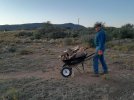- Joined
- Feb 28, 2009
- Messages
- 416
Finished stacking wood at my grandparents' place today. My dad and I work over the summer to split and stack it to dry and then move it into the shed around this time of year. There were a bunch of oyster mushrooms growing on some of the maple pieces.





Benjamin-I have never seen or heard of those before. Of course I have lived a somewhat sheltered life ... under a wood pile. Are they edible?







